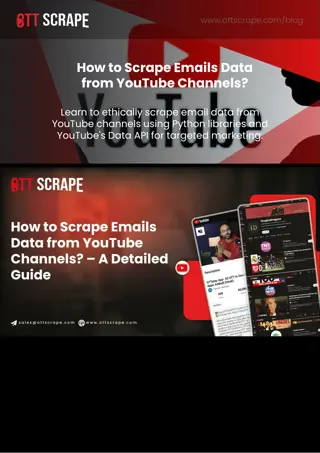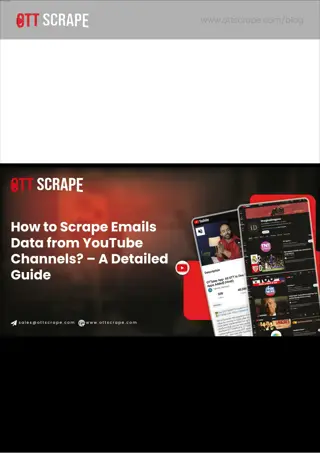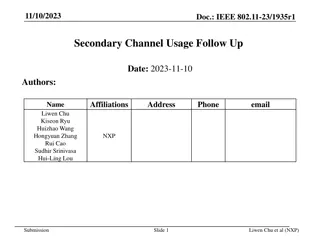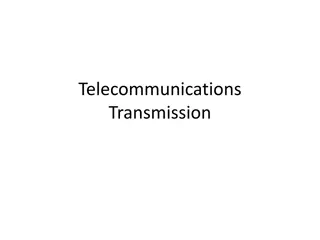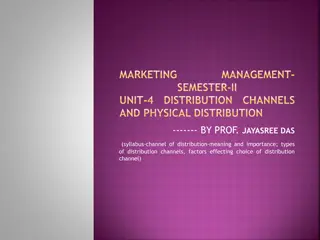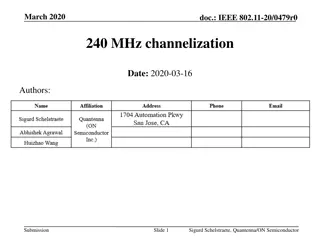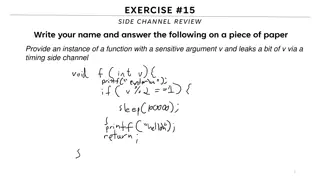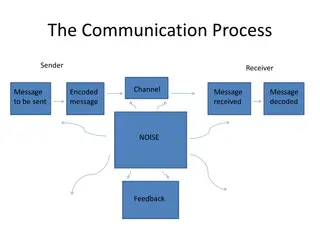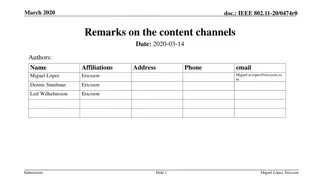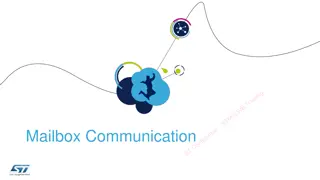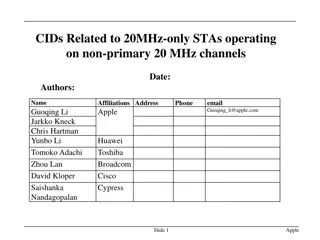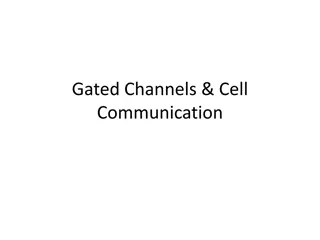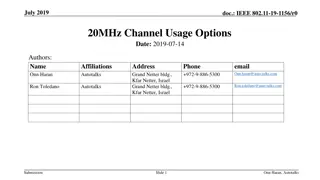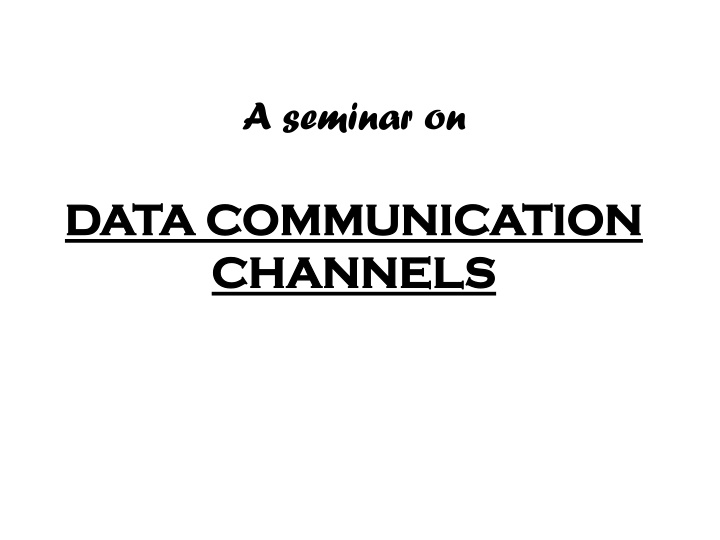
Understanding Data Communication Channels and Media
Explore the essentials of data communication, channels, and media including twisted pair wire, coaxial cable, and more. Discover the advantages, disadvantages, and applications of each medium in transferring data effectively.
Download Presentation

Please find below an Image/Link to download the presentation.
The content on the website is provided AS IS for your information and personal use only. It may not be sold, licensed, or shared on other websites without obtaining consent from the author. If you encounter any issues during the download, it is possible that the publisher has removed the file from their server.
You are allowed to download the files provided on this website for personal or commercial use, subject to the condition that they are used lawfully. All files are the property of their respective owners.
The content on the website is provided AS IS for your information and personal use only. It may not be sold, licensed, or shared on other websites without obtaining consent from the author.
E N D
Presentation Transcript
A seminar on DATA COMMUNICATION DATA COMMUNICATION CHANNELS CHANNELS
Communication Communication is the process of transferring the message from one point to another. Element Of Communication 1)Sender(Source) 2)Medium 3)Receiver
Data Communication Data Communication means transferring the data from one place to another. But ,in this case the Sender and Receiver both are machines like Computers, printer etc and Medium may be 1.Twisted Pair Wire 2.Coaxial Cable 3.Microwave System 4.Satellite System 5.Optical Fibers
Data Communication Channels Or Media Twisted Pair Wire Coaxial Cable Microwave System Satellite System Optical Fibers
Twisted Pair Wire A twisted pair wire consist of two bunches of thin Copper Wires, each bunch is enclosed separately in a plastic insulation and then twisted around each other to reduce the interference by the adjacent wires. It is also called as UTP that is Unshielded Twisted-Pair cable because other than the plastic coating around the two individual bunches of copper wire nothing is shields it from outside interference. Uses:- UTP cables are used for local telephone communication and for short distance digital data transmission (up to 1 KM). They are also used to connect Terminals to the main computer, if thy are placed at a short distance from the main computer. Data Transmission speed of up to 9600 bits per seconds can be achieved if distance is not more than 1 km. Advantage:- It is an inexpensive medium of data transmission. They are easy to install and use. Disadvantages:- Their use is limited because they easily pick up the noise signals, which result into high error rates, if distance is more than 1 km.
Coaxial Cable Co-axial cables are groups of specially wrapped and insulated wire lines,transmite the data at high rates. Consist of a Central Copper Wire surrounded by PVC insullation,over which sleeve of copper mesh is placed. The metal sleeve is shielded by outer shield of thick PVC material. The signals is transmitted by inner copper wire. Offer higher Bandwidth Transmit Digital signals at a rate of 10 Mega bits per seconds. They are used for long distance telephone lines and as a cable for cable TV. Provides higher noise immunity and provide cleaner and crisper data transmission without the loss of signals.
Microwave System It is popular method, since it does not required the expenses of laying cables. Uses high frequency Radio signals. However, at microwave frequencies, the electromagnetic wave can not pass the obstacles. So it is necessary that the microwave transmission should be in a line-of- sight. It means that the transmitter and receiver of microwave transmission should be in line-of-sight. It is not possible for very long distance transmission. Moreover signals become weaker after travelling a certain distance and required power amplification process. In order to overcome this problems ,microwave uses REPETERS at intervals about 25 to 30 Kms in between transmitting and receiving station. Permits the data transmission of up 16 Giga bits per seconds. Initial installation cost is high.
Satellite System Main problem with microwave is that the obstacles creates the problem of line-of- sight. So several Repeaters is required to placed between two points which increase the cost of transmission. A Communication satellite is a microwave relay station placed in outer space. This satellite is launched either by rockets or by space shuttles and are precisely positioned 36000 kms above the equator with an orbit speed, which exactly matches with earth rotation speed. Hundreds are satellite are now in orbit to handle International and domestic data, voice and video communication. As shown in the figure the microwave signals is transmitted from a transmitter on earth to the satellite positioned in space, by the time this signals reaches the satellite it becomes weaker due to 36000 kms travelling. A Transponder, which mounted on satellite amplifies the weak signals and transmit it back to the earth. Then this signals is received by the receiving station on earth. A satellite contains the number of transponders therefore satellite has a enormous data communication capacity.
Advantages of Satellite System Data transmission costs are independent of the distance between two points as long as the two points are covered by the satellite. Since it contains the number of transponders it has a enormous data transmission capacity. Error detection is made in this system because a transmitting station can receive its data back and check whether a satellite has transmitted its data correctly or not .If not then it can retransmit the data. 12 Disadvantages of Satellite System The initial cost of placing satellite in orbit is very high. The manner in which satellite communication system works ,any data sent to the satellite for the transmission ,automatically gets broadcast to all receiving stations within the satellite s range. So special security measures are required to taken for unauthorized tampering of data.
It is hair-thin threads of glass or plastic, which serves a data transmission medium as copper and coaxial cable. It is made of glass, plastic or silica. The basic difference is that the optical fiber transmit the light signals instead of electrical signals. Transmit data at much high speed because light travels much faster than electricity. Optical fiber consist of three layers-the inner core, a cladding around it and the outer protecting coating. Inner core-Consist of bunches of optical fibers. Clading around it is made of plastic or silica.
Towards its source side is one converter, which converts the electrical signals into light waves. The converter either uses the Light Emitting Diode(LED) or a laser diode to convert electric signals into light signals. These light waves are then transmitted over the optical fiber to the receivers end. At the receiver s end, another converter is placed, which detects the light waves and converts back to electrical signals. It uses the Photoelectric Diodes for this purpose. Advantages of Optical Fiber:- 1)Transmit the large amount of data at very high speed and long distance. 2)They are light in weight and much smaller in size than copper wire and coaxial cable. 3)It provides security against the unauthorized access of data because its very difficult to tap the optical signals. Disadvantages of Optical Fiber:- 1) Optical fibers are fragile so that they can not be turned at sharp corners and this creates the problem in physical laying of the cable. 2) Joining of two fiber optical cable is not easy like twisted pair wire or coaxial cable ,it required the special equipment to do so.




